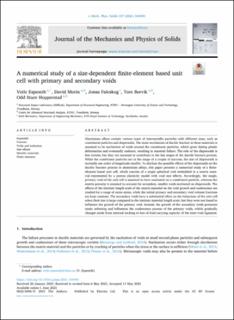| dc.description.abstract | Aluminium alloys contain various types of intermetallic particles with different sizes, such as constituent particles and dispersoids. The main mechanism of ductile fracture in these materials is assumed to be nucleation of voids around the constituent particles, which grow during plastic deformation and eventually coalesce, resulting in material failure. The role of the dispersoids is less certain, but they are assumed to contribute in the last stages of the ductile fracture process. While the constituent particles are in the range of a couple of microns, the size of dispersoids is normally one order of magnitude smaller. To disclose the possible effects of the dispersoids on the ductile fracture process in aluminium alloys, this paper presents a numerical study of a finite-element based unit cell, which consists of a single spherical void embedded in a matrix material represented by a porous plasticity model with void size effects. Accordingly, the single, primary void of the unit cell is assumed to have nucleated on a constituent particle, whereas the matrix porosity is assumed to account for secondary, smaller voids nucleated on dispersoids. The effects of the intrinsic length scale of the matrix material on the void growth and coalescence are studied for a range of stress states, while the initial primary and secondary void volume fractions are kept constant. The secondary voids have a substantial effect on the behaviour of the unit cell when their size is large compared to the intrinsic material length scale, but they were not found to influence the growth of the primary void. Instead, the growth of the secondary voids promotes strain softening and influences the coalescence process of the primary voids, which gradually changes mode from internal necking to loss of load-carrying capacity of the inter-void ligament. | en_US |

